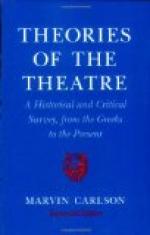IV
THE BOUNDARIES OF APPROBATION
When Hamlet warned the strolling players against making the judicious grieve, and when he lamented that a certain play had proved caviare to the general, he fixed for the dramatic critic the lower and the upper bound for catholicity of approbation. But between these outer boundaries lie many different precincts of appeal. The Two Orphans of Dennery and The Misanthrope of Moliere aim to interest two different types of audience. To say that The Two Orphans is a bad play because its appeal is not so intellectual as that of The Misanthrope would be no less a solecism than to say that The Misanthrope is a bad play because its appeal is not so emotional as that of The Two Orphans. The truth is that both stand within the boundaries of approbation. The one makes a primitive appeal to the emotions, without, however, grieving the judicious; and the other makes a refined appeal to the intelligence, without, however, subtly bewildering the mind of the general spectator.
Since success is to a play the breath of life, it is necessary that the dramatist should please his public; but in admitting this, we must remember that in a city so vast and varied as New York there are many different publics, which are willing to be pleased in many different ways. The dramatist with a new theme in his head may, before he sets about the task of building and writing his play, determine imaginatively the degree of emotional and intellectual equipment necessary to the sort of audience best fitted to appreciate that theme. Thereafter, if he build and write for that audience and that alone, and if he do his work sufficiently well, he may be almost certain that his play will attract the sort of audience he has demanded; for any good play can create its own public by the natural process of selecting from the whole vast theatre-going population the kind of auditors it needs. That problem of the dramatist to please his public reduces itself, therefore, to two very simple phases: first, to choose the sort of public that he wants to please, and second, to direct his appeal to the mental make-up of the audience which he himself has chosen. This task, instead of hampering the dramatist, should serve really to assist him, because it requires a certain concentration of purpose and consistency of mood throughout his work.




